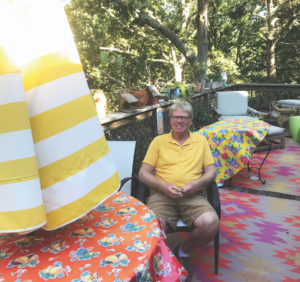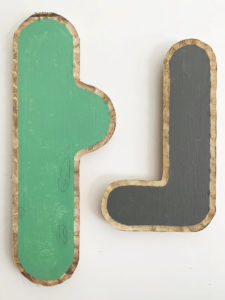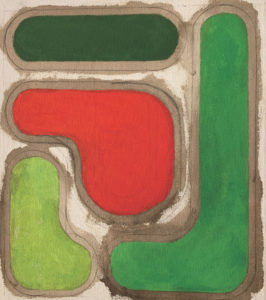
“A year ago, I became an orphan,” says Bailey Bob Bailey on the back deck of his Truro home. “Dad died on Aug. 25, 2019. He was 89. Mom had died in 2013. I have one brother, and he died in 2016.” Bailey, who, by his own description, is usually “uppity-up,” a can-do guy, was hit hard. “I’m one of those people who has never been blocked.” Well, never say never. For several months, he stopped making art.
“I told myself I was going to grieve on nature’s time,” Bailey says. “I’ll make art when I make art.” And then, sometime in February, he had a dream. “I saw this painting — it was kind of a constructed painting, and I thought I should make it. I started working on these shapes.”
The result is a body of work that Bailey is proud to show, part of a group exhibit at the Schoolhouse Gallery in Provincetown, opening Friday. It represents one of the times in Bailey’s life where his creative imagination and his sense of what it means to be an artist come together.

Bailey is well established in Provincetown’s art firmament: he’s shown his work here as a sculptor and painter for decades, at DNA Gallery and the storied artStrand cooperative, of which he was a founder and manager. He’s curated several landmark shows at the Provincetown Art Association and Museum and was honored there with an award for artistic excellence at its 2016 gala. He works as facilities manager of the Fine Arts Work Center, where he’s also on the visual arts committee. He and his wife, artist Breon Dunigan, live year-round in Truro and raised their grown son, Liam, here.
But Bailey’s journey to this level of accomplishment was anything but a given. He built this life as an artist with the force of existential will, reconciling an attraction to art and a love of creativity with a sense of who he is.
He grew up the son of an F.B.I. assistant director. “He had a pinnacle job,” Bailey says of his dad. “He was in charge of all the files and had 3,000 people working under him.” Bailey’s mom was a housewife, and the family moved around the country as his father moved up the ranks at the F.B.I.
“My whole thing growing up,” Bailey says, “was that I was not an artist. An artist was a crazy, insane genius. It was never even an option for me. I didn’t have a teacher who said, ‘Come, do this.’ I didn’t have any mentorship.”

Bailey went to Virginia Tech for two years before he hit a wall. “I had three majors, but I had no awareness of myself,” Bailey says. “I wasn’t able to be a regular Joe. I was a failure at it.” He left school and worked in restaurants in Washington, D.C. When a friend said she had been to the National Gallery of Art, Bailey asked, “If you ever do that again, would you take me?”
They went. “I thought I’d found the meaning of life,” Bailey says. “For the first time, I was able to actually see the world through visual means. I found myself going to all the museums. Then I started drawing and painting, the very first time.”
But he didn’t see himself as a creative artist. He wanted to work in a museum. “I went back to Virginia Tech. I was the first graduate there in art history.” He got a job as an assistant guard at the Phillips Collection in D.C. “Within two months, I was hanging exhibitions. I loved contemporary art. I was taken by minimalism.”
Bailey studied furniture design and got skilled in woodworking and metal, then went for an M.F.A. at Virginia Commonwealth University. But it wasn’t until he’d been through a summer residency at the Skowhegan School of Painting and Sculpture and a fellowship, in 1989-1990, at the Fine Arts Work Center in Provincetown that he came into his own.
“When I got here, I immediately fell in love with the place first, the natural space. But it was really a joy to realize that artists are anyone. It was a real opening up for me. I knew I was going to stay in Provincetown.” He returned for a second-year fellowship, moved to New York City — “Why? Because that’s what artists do” — and happily returned to Provincetown for good.
Artistically, he went through phases. When his son was born, he switched from oils to less toxic casein, and got infatuated with the work of Georges Braque. He had some success, but the work was imitative, and for Bailey, to be an artist, “You have to make something unique.”

He read a book about the artist Robert Irwin, Seeing Is Forgetting the Name of the Thing One Sees, and had another epiphany. He related to Irwin’s expansive curiosity and sense of renewal. “I suddenly saw art in everything in my whole life,” Bailey says. “In walks. The way my kid looked. I started everything and anything in my artwork. It’s when I started to make shaped canvases. When people ask me, ‘What do you do?’ I always say, ‘All of the above.’ ”
His father’s death may have shaken him, but Bailey is back reinventing himself. Even the name, Bailey Bob Bailey, which he adopted several years ago, reflects that embrace of the artist persona over being an ordinary Bob. “You have to make a leap somewhere in your life, where it’s just you,” Bailey says.
Back to Schoolhouse
The event: New work by Bailey Bob Bailey, part of a group show with Ramon S. Alcolea, Damien Hoar de Galvan, Sarah Lutz, Dermot Meagher, Richard Saja, and Simone Siegel
The time: Opening Friday, Sept. 4; on view through Oct. 4
The place: Schoolhouse Gallery, 494 Commercial St., Provincetown
The cost: Free



